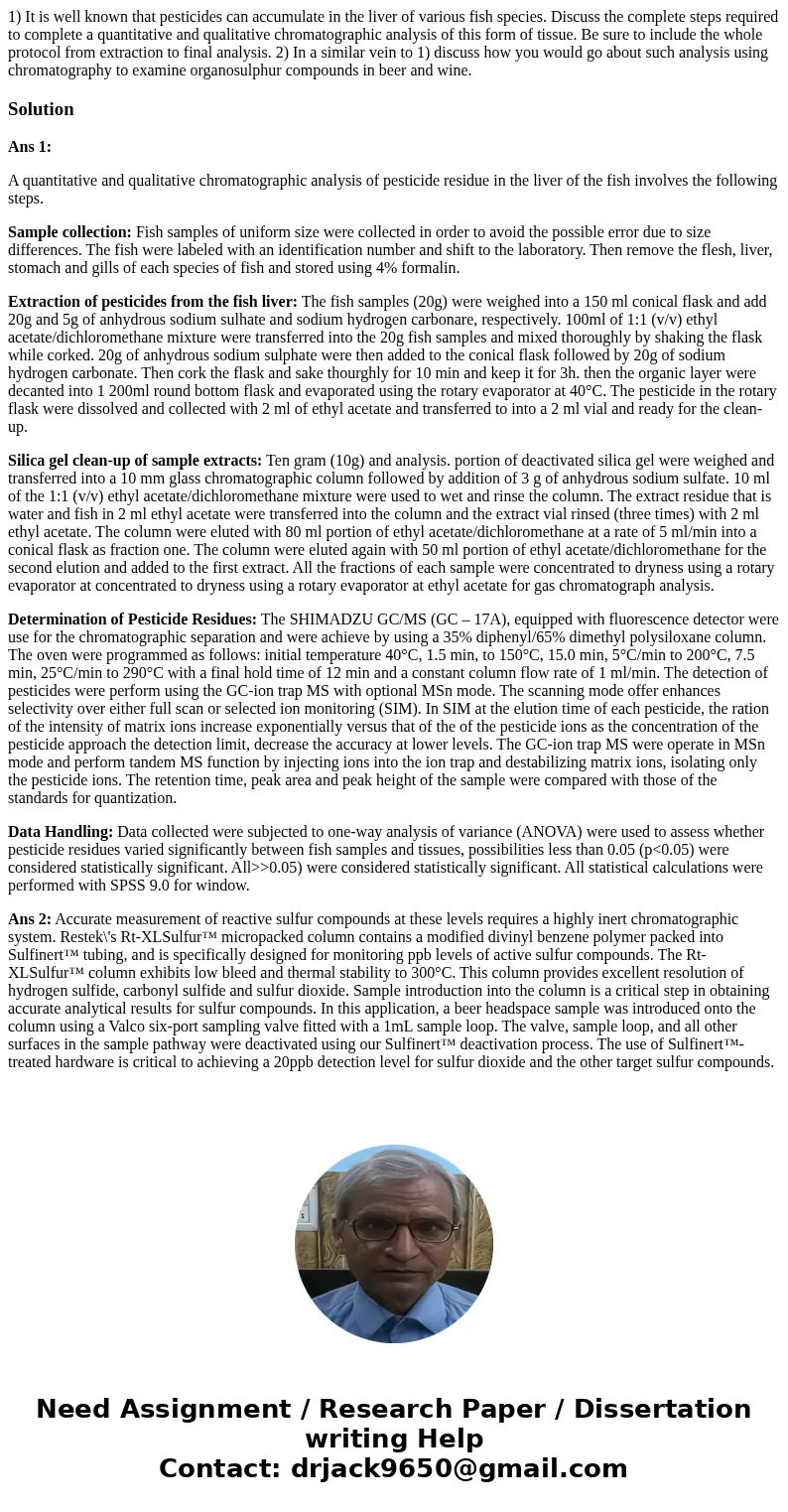1 It is well known that pesticides can accumulate in the liv
1) It is well known that pesticides can accumulate in the liver of various fish species. Discuss the complete steps required to complete a quantitative and qualitative chromatographic analysis of this form of tissue. Be sure to include the whole protocol from extraction to final analysis. 2) In a similar vein to 1) discuss how you would go about such analysis using chromatography to examine organosulphur compounds in beer and wine.
Solution
Ans 1:
A quantitative and qualitative chromatographic analysis of pesticide residue in the liver of the fish involves the following steps.
Sample collection: Fish samples of uniform size were collected in order to avoid the possible error due to size differences. The fish were labeled with an identification number and shift to the laboratory. Then remove the flesh, liver, stomach and gills of each species of fish and stored using 4% formalin.
Extraction of pesticides from the fish liver: The fish samples (20g) were weighed into a 150 ml conical flask and add 20g and 5g of anhydrous sodium sulhate and sodium hydrogen carbonare, respectively. 100ml of 1:1 (v/v) ethyl acetate/dichloromethane mixture were transferred into the 20g fish samples and mixed thoroughly by shaking the flask while corked. 20g of anhydrous sodium sulphate were then added to the conical flask followed by 20g of sodium hydrogen carbonate. Then cork the flask and sake thourghly for 10 min and keep it for 3h. then the organic layer were decanted into 1 200ml round bottom flask and evaporated using the rotary evaporator at 40°C. The pesticide in the rotary flask were dissolved and collected with 2 ml of ethyl acetate and transferred to into a 2 ml vial and ready for the clean-up.
Silica gel clean-up of sample extracts: Ten gram (10g) and analysis. portion of deactivated silica gel were weighed and transferred into a 10 mm glass chromatographic column followed by addition of 3 g of anhydrous sodium sulfate. 10 ml of the 1:1 (v/v) ethyl acetate/dichloromethane mixture were used to wet and rinse the column. The extract residue that is water and fish in 2 ml ethyl acetate were transferred into the column and the extract vial rinsed (three times) with 2 ml ethyl acetate. The column were eluted with 80 ml portion of ethyl acetate/dichloromethane at a rate of 5 ml/min into a conical flask as fraction one. The column were eluted again with 50 ml portion of ethyl acetate/dichloromethane for the second elution and added to the first extract. All the fractions of each sample were concentrated to dryness using a rotary evaporator at concentrated to dryness using a rotary evaporator at ethyl acetate for gas chromatograph analysis.
Determination of Pesticide Residues: The SHIMADZU GC/MS (GC – 17A), equipped with fluorescence detector were use for the chromatographic separation and were achieve by using a 35% diphenyl/65% dimethyl polysiloxane column. The oven were programmed as follows: initial temperature 40°C, 1.5 min, to 150°C, 15.0 min, 5°C/min to 200°C, 7.5 min, 25°C/min to 290°C with a final hold time of 12 min and a constant column flow rate of 1 ml/min. The detection of pesticides were perform using the GC-ion trap MS with optional MSn mode. The scanning mode offer enhances selectivity over either full scan or selected ion monitoring (SIM). In SIM at the elution time of each pesticide, the ration of the intensity of matrix ions increase exponentially versus that of the of the pesticide ions as the concentration of the pesticide approach the detection limit, decrease the accuracy at lower levels. The GC-ion trap MS were operate in MSn mode and perform tandem MS function by injecting ions into the ion trap and destabilizing matrix ions, isolating only the pesticide ions. The retention time, peak area and peak height of the sample were compared with those of the standards for quantization.
Data Handling: Data collected were subjected to one-way analysis of variance (ANOVA) were used to assess whether pesticide residues varied significantly between fish samples and tissues, possibilities less than 0.05 (p<0.05) were considered statistically significant. All>>0.05) were considered statistically significant. All statistical calculations were performed with SPSS 9.0 for window.
Ans 2: Accurate measurement of reactive sulfur compounds at these levels requires a highly inert chromatographic system. Restek\'s Rt-XLSulfur™ micropacked column contains a modified divinyl benzene polymer packed into Sulfinert™ tubing, and is specifically designed for monitoring ppb levels of active sulfur compounds. The Rt-XLSulfur™ column exhibits low bleed and thermal stability to 300°C. This column provides excellent resolution of hydrogen sulfide, carbonyl sulfide and sulfur dioxide. Sample introduction into the column is a critical step in obtaining accurate analytical results for sulfur compounds. In this application, a beer headspace sample was introduced onto the column using a Valco six-port sampling valve fitted with a 1mL sample loop. The valve, sample loop, and all other surfaces in the sample pathway were deactivated using our Sulfinert™ deactivation process. The use of Sulfinert™-treated hardware is critical to achieving a 20ppb detection level for sulfur dioxide and the other target sulfur compounds.

 Homework Sourse
Homework Sourse